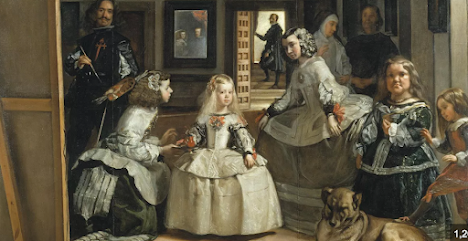Baroque Blog: Las Meninas
The painting, Las Meninas by Diego Velázquez made in King Phillip IV's Alcázar palace in Madrid, Spain in 1656 portrays the Spanish royal family as its subject. This painting has been very popular over the years as it has many perspectives which can be puzzling and intriguing for the viewers' mind. Velázquez features himself as the artist within his own painting and the painting is composed of a very odd cast of characters such as a nun, a princess, a dwarf, the infanta, Margarita Teresa who was the five year old daughter of king Phillip IV, the ladies-in-waiting also known as the meninas, Doña Isabel de Velasco, Doña María Agustina Sarmiento de Sotomayor. among other characters. The five year old infanta is featured in the center of the painting and she's painted in a much fairer tone which renders her as the center of the art work. The influence of royalty is demonstrated through the painting's location, its' subject matter and the artists' inclusion. This baroque style of painting used an innovative approach to perspective and composition and has space and light. The reflection of the King and the Queen are also seen in the mirror at the back of the room.
Diego Velázquez, Las Meninas – Smarthistory. (n.d.). Smarthistory.org.
https://smarthistory.org/diego-velazquez-las-meninas/
Artsper Magazine. (2022, January 25). Understanding Velázquez’s Iconic Las Meninas Painting. Artsper Magazine.
https://blog.artsper.com/en/a-closer-look/understanding-velazquezs-iconic-las-meninas-painting/




I loved reading your thoughts! The way the painting offers so many different perspectives is quite interesting, and I appreciate you highlighting the diverse characters. Including himself in the painting adds such a unique layer, making me think about the artist's perspective within the royal context especially with the reflections of the King and Queen in the mirror. It really shows their power. Thanks for sharing your insights!
ReplyDeleteOne of my favorite concepts in art is how at first glance you see one story, and after many glances the story develops, but this painting is interesting because the more I look at it the more I'm not sure which story is taking place. I wonder if she is getting ready for some type of event? It's so interesting how in the Baroque era, the use of darker shadows and light mixed with central focus points create such dramatic effects.
ReplyDeleteI love this piece, it's so visually interesting. While the color palette itself is on the muted and dull side, I love how the way your eye can bounce around the piece. The little girl is signaled out as more of a center piece I feel less because of the tone of her clothes (though they do play a good role) but also because of the implied lines. Both the girls next to her stare directly at her, which makes us the viewer want to follow their eyes. But the genius part is that instead of staring directly at the viewer, her head is tilted in the direction of the older woman to her right, which brings out eyes that way. And then, right next to that woman we can see another little girl who's staring down directly at a dog. While there's so much going on, I feel like the artist has a lot of guiding information in the piece that can carry your eyes throughout it. I'm also particularly fond of the way the artist stares directly at the viewer, it feels a bit meta and humorous to me.
ReplyDeleteOverall, you did a lovely job on the analysis! Keep up the great work!